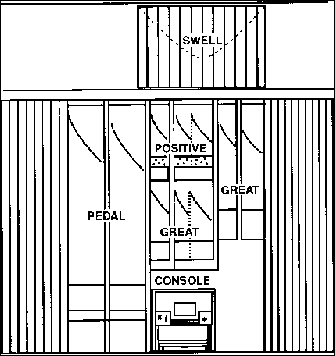
The instrument is a magnificent example of its kind, exhibiting some of the spendid results wrought by the earlier 20th-century reforms in organ building. Rudolph von Beckerath built up his firm in Hamburg himself and was responsible for training many of today's leading organ builders. His own background was a highly cultured one; he was the son of a painter known for his famous tempera of Brahms -- sitting at his piano smoking a cigar -- as well as sketches of that composer conducting. Sadly, Von Beckerath died on 20 November 1976, before the final installation of the Baxter's organ. It is in fact one of the last in the design with which he was personally involved. Cape Town -- and the University of Cape Town in particular -- is indeed fortunate to possess such an instrument. In the American organ journal, The Diapason, of February 1977, some commentary by Paul Jenkins gives a clear idea of Von Beckerath's vision of contemporary tonal design in organ building. Jenkins recounts that "Once, when asked if he built a 'Baroque' organ, Mr Beckerath responded that he built a 'modern organ'. This he accomplished, basing his work on time-honoured and proven principles which embraced the best of various tonal traditions. These tonal colours he synthesized and used in a manner which combined into a unified and well-organised whole. Although he would have confessed that the 17th and 18th century North German school provided his primary inspiration and the foundation upon which he based his concepts, his many years in France during the 1930s had their influence."
The opening recital featured works from across the great spectrum of the organ repertoire and, in spite of the dry acoustic of the new concert hall, the organ at once revealed its suitability as a medium for music ranging from Clérambault to Messiaen. In addition to its value as a concert instrument, here also was an up-to-date teaching instrument: the SACM became the first teaching institution in South Africa to invest in the advantages of a mechanical action instrument (by then already commonplace in Europe and America).
Since its inauguration, the Von Beckerath organ has given Western Cape -- indeed, South African -- audiences opportunities to hear international and celebrity organ artists in a comfortable venue with the performer in full view. Among the stars of the concert organists who have placed in the Baxter Concert Hall are Dame Gillian Weir, Lionel Rogg, Daniel Chorzempa and Martin Haselböck. Regular organ recitals are presented by the SA College of Music in its annual concert programmes and the Cape Organ Guild has taken a strong interest by programming some of its recitals -- and some Barrow-Dowling Scholarship Competitions -- using the instrument.

